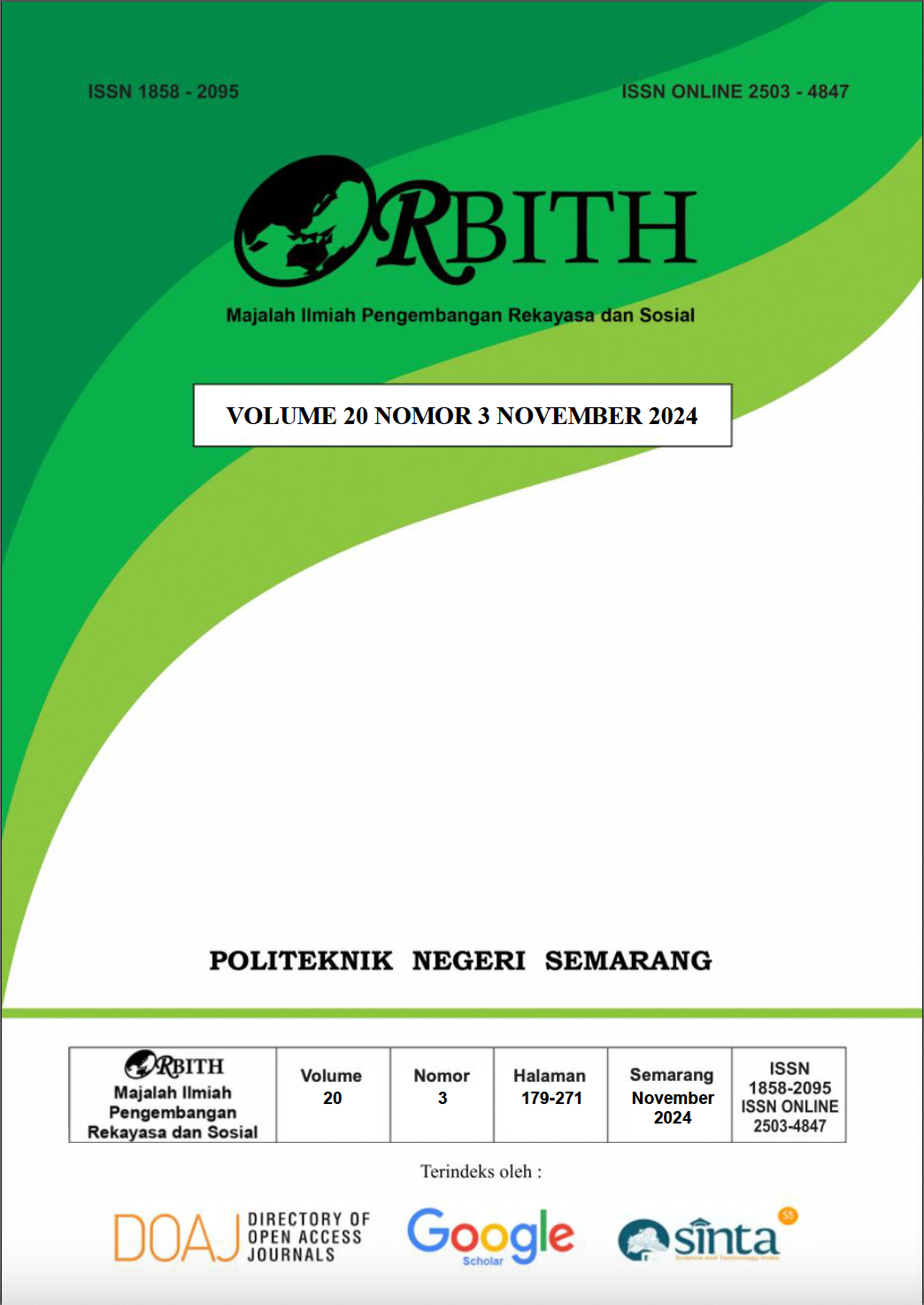RANCANG BANGUN SISTEM INFORMASI PENGELOLAAN PROJECT-BASED LEARNING DENGAN METODE PROTOTYPING
DOI:
https://doi.org/10.32497/orbith.v20i3.6258Keywords:
project management, PBL, usability testing, software evaluation.Abstract
Abstrak Keberhasilan sebuah instansi yang bergerak di bidang pendidikan, bukan hanya diperhitungkan dari ketepatan dan banyaknya lulusan yang dihasilkan, melainkan juga dari bagaimana instansi tersebut mengelola berbagai data yang ada untuk mendapatkan suatu informasi yang diperlukan oleh civitas akademika instansi yang bersangkutan. Salah satu cara untuk mengubah data agar dapat menjadi informasi adalah dengan mengolahnya pada sebuah sistem informasi. Sebuah sistem informasi dapat memudahkan birokrasi yang selama ini dikeluhkan oleh pada dosen dan mahasiswa adalah Sistem Informasi Pengelolaan Project-Based Learning (PBL). Penelitian ini bertujuan untuk mengevaluasi tingkat kegunaan dan penerimaan sistem menggunakan metode usability testing dengan System Usability Scale (SUS) serta User Acceptance Testing (UAT). Sebanyak 10 pengguna berpartisipasi dalam pengujian untuk menilai aspek navigasi, kemudahan penggunaan, serta kesesuaian sistem dengan kebutuhan pengguna. Hasil usability testing menunjukkan skor SUS sebesar 78, yang mengindikasikan bahwa sistem memiliki tingkat kegunaan yang baik dan dapat diterima oleh pengguna. Pengujian UAT menilai lima aspek utama, yaitu fungsionalitas sistem, kemudahan penggunaan, kinerja, keamanan dan stabilitas, serta kepuasan pengguna, dengan hasil skor rata-rata 4.58 dari 5. Hasil ini menunjukkan bahwa sistem telah memenuhi kebutuhan pengguna dan dapat digunakan secara efektif dalam lingkungan kerja. Kata kunci: manajemen proyek, PBL, usability testing, evaluasi perangkat lunak. Abstract The success of an educational institution is not only measured by the accuracy and number of graduates produced but also by how the institution manages various data to obtain necessary information for its academic community. One way to transform data into useful information is by processing it within an information system. An information system that can streamline the bureaucratic processes often criticized by lecturers and students is the Project-Based Learning (PBL) Management Information System. This study aims to evaluate the usability and user acceptance of the system using usability testing with the System Usability Scale (SUS) and User Acceptance Testing (UAT) methods. A total of 10 users participated in the testing to assess navigation, ease of use, and the system”™s alignment with user needs. The usability testing results indicated a SUS score of 78, signifying a good level of usability and user acceptance. The UAT evaluation assessed five key aspects: system functionality, ease of use, performance, security and stability, and user satisfaction, yielding an average score of 4.58 out of 5. These results demonstrate that the system meets user requirements and can be effectively utilized in a working environment. Keywords: project management, PBL, usability testing, software evaluation.References
Alawiyah, T., Mulyani, Y. S., Gunawan, M. A., Setiaji, R., & Nurdin, H. (2022). Sistem Informasi Manajemen Proyek (SIMAPRO) Berbasis Web (Studi Kasus: PT. Arya Bakti Saluyu). Jurnal Khatulistiwa Informatika, 10(2), 129”“135. https://doi.org/10.31294/jki.v10i2.14061
Amarudin, Sofiandri A. (2018) . Perancangan dan Implementasi Aplikasi Ikhtisar Kas Masjid Istiqomah Berbasis Desktop. Jurnal Tekno Kompak, 12 (2), 51-56. https://doi.org/10.33365/jtk.v12i2.148
Brown, D. (2021). UX Design and Prototyping with Figma. Apress.
Citra Nadya Dwi Irianti, Imam Cholissodin, & Achmad Arwan. (2021). Pengembangan Sistem Informasi Manajemen Proyek Properti Berbasis Website (Studi Kasus: PT. Sona Citra Mandiri). Jurnal Pengembangan Teknologi Informasi Dan Ilmu Komputer., 5(6), 2478”“2485.
Mawaddah, M., & Devitra, J. (2023). Sistem Informasi Manajemen Proyek Konstruksi Pada CV. Lumbung Agroendo. Jurnal Manajemen Sistem Informasi, 8(3), 520”“529. https://doi.org/10.33998/jurnalmsi.2023.8.3.1487
Preece, J., Rogers, Y., & Sharp, H. (2019). Interaction Design: Beyond Human-Computer Interaction. Wiley.
Pressman, R. S., & Maxim, B. R. (2020). Software Engineering: A Practitioner”™s Approach. McGraw-Hill.
Putri, M. P., & Bobby, B. (2020). Sistem Informasi Manajemen Proyek PT. Samudera Perkasa Konstruksi Berbasis Web. MATRIK: Jurnal Manajemen, Teknik Informatika Dan Rekayasa Komputer, 20(1), 85”“96. https://doi.org/10.30812/matrik.v20i1.716
Sari Sakti, E. M., & Rendra, H. (2022). Perancangan Sistem Informasi Manajemen Proyek Pembangunan SPBU untuk PT. XYZ. Ikraith-Informatika, 6(3). https://doi.org/10.37817/ikraith-informatika.v6i3.2205.
Downloads
Published
Issue
Section
License
Authors who publish with this journal agree to the following terms:Authors retain copyright and grant the journal right of first publication with the work simultaneously licensed under a Creative Commons Attribution License that allows others to share the work with an acknowledgement of the work's authorship and initial publication in this journal.
Authors are able to enter into separate, additional contractual arrangements for the non-exclusive distribution of the journal's published version of the work (e.g., post it to an institutional repository or publish it in a book), with an acknowledgement of its initial publication in this journal.
Authors are permitted and encouraged to post their work online (e.g., in institutional repositories or on their website) prior to and during the submission process, as it can lead to productive exchanges, as well as earlier and greater citation of published work (See The Effect of Open Access).






